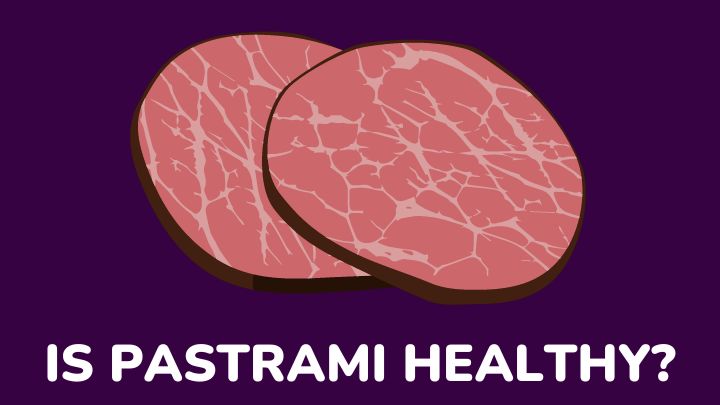Is pastrami healthy? What impact does its ingredients have on your health?
Pastrami is a popular deli meat that originates from beef. It has its roots in Jewish communities in Romania and Turkey before becoming a New York City deli staple.
Its distinct flavor arises from a blend of spices, smoke, and brine. However, its health implications remain a topic of concern for many.
In this article, you’ll find out whether pastrami is a healthy choice and examine its nutritional content alongside its health benefits and risks.
What is pastrami?
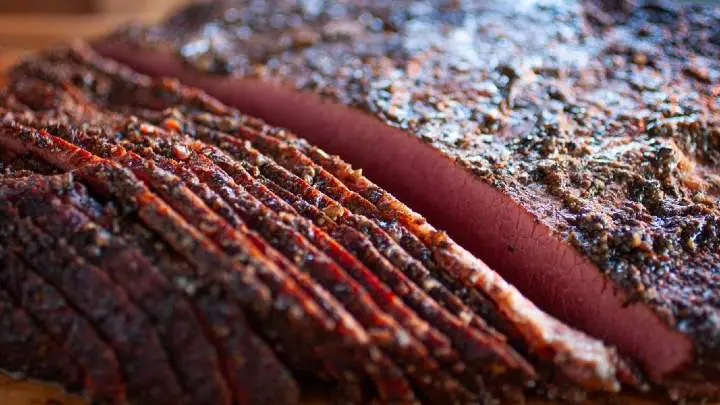
Pastrami is a delicious deli meat with a rich, smoky flavor that originated in Romania. It’s made from beef brisket that’s been brined, seasoned with spices like coriander and garlic, then smoked and steamed to perfection.
This mouthwatering meat has found its way into various cuisines worldwide, but it’s particularly popular in delis and sandwich shops across the United States, especially in cities like New York City, where it’s a beloved ingredient in the iconic pastrami sandwich.
Pastrami is also enjoyed in Jewish delicatessens and eateries in cities with large Jewish populations, such as Los Angeles and Chicago.
Whether piled high on rye bread with mustard or layered in a classic Reuben sandwich, pastrami is a flavorful addition to any meal, cherished by food lovers everywhere.
What is pastrami made of?
Pastrami is crafted from a handful of simple yet flavorful ingredients, each contributing to its distinctive taste and texture.
Beef brisket
Beef brisket provides the foundation for pastrami. Known for its rich, beefy flavor and tender texture, brisket is brined and seasoned before undergoing the smoking and steaming process.
Brine
A mixture of water, salt, and sugar, the brine is crucial for enhancing flavor and moisture in the brisket. It helps tenderize the meat and infuse it with savory and salty notes.
Spices
Pastrami’s signature taste comes from a blend of spices, including coriander, black pepper, garlic, and sometimes mustard seeds. These spices add depth and complexity to the meat, creating a harmonious balance of flavors.
Smoke
After brining and seasoning, the brisket is smoked over hardwood chips, imparting a smoky aroma and enhancing its overall taste. The smoking process adds depth and character to the pastrami, giving it that irresistible smoky flavor.
Steam
Following the smoking phase, the brisket is steamed to ensure tenderness and juiciness. Steaming helps lock in moisture and further tenderizes the meat, resulting in a succulent and flavorful final product.
The most common types of pastrami
Pastrami comes in various forms, each offering a unique twist on this beloved deli meat. Here are the most common types:
Beef pastrami
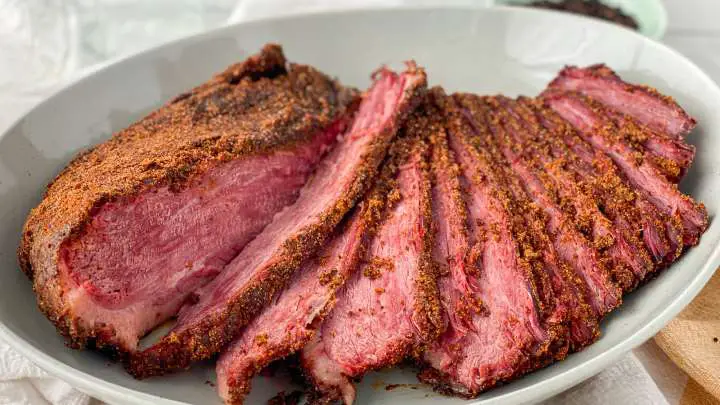
Beef pastrami is made from beef brisket and boasts a rich, meaty flavor with robust notes of coriander, garlic, and black pepper.
It’s traditionally seasoned with spices like coriander and garlic, then smoked and steamed to perfection. Beef pastrami is a staple in delis and sandwich shops worldwide, prized for its bold taste and tender texture.
Turkey pastrami
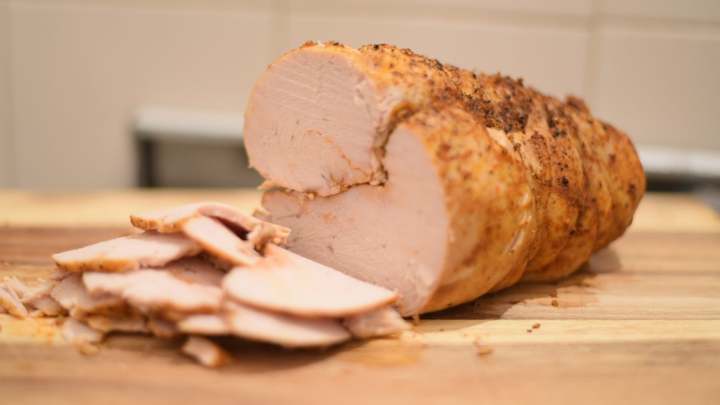
A leaner alternative to beef pastrami, turkey pastrami is made from turkey breast instead of beef brisket.
It offers a lighter flavor profile with hints of smokiness and savory spices, while still providing the satisfying taste that pastrami enthusiasts crave.
Turkey pastrami is an excellent option for those looking to reduce their red meat intake without sacrificing flavor.
Vegetarian and vegan pastrami
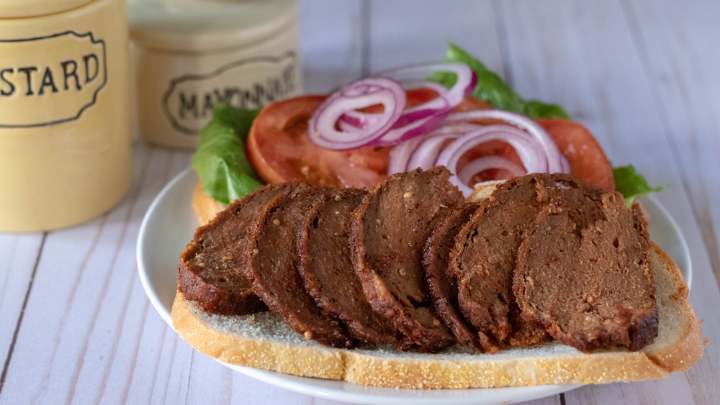
For those following a plant-based diet or looking for meat-free alternatives, vegetarian and vegan pastrami offer the same delicious taste without any animal products.
These options are typically made from seitan, tofu, or other plant-based proteins, seasoned with spices to mimic the flavor of traditional pastrami.
Vegetarian and vegan pastrami are versatile options that can be used in sandwiches, salads, and other dishes, providing a satisfying and flavorful meatless alternative.
What is the nutritional profile of pastrami?
According to the US Department of Agriculture, a 100-gram serving of pastrami contains:
- Calories: 147
- Total Fat: 6g
- Saturated fat: 2.7g
- Cholesterol: 68 mg
- Sodium: 1,078 mg
- Potassium: 210 mg
- Total Carbohydrate: 0.4 g
- Dietary fiber: 0g
- Granulated Sugar: 0.1 g
- Protein: 22g
- It also contains calcium, iron, vitamin D, vitamin B6, cobalamin, and magnesium in small quantities.
Health benefits of pastrami
While pastrami is often enjoyed for its delicious flavor, it also offers several health benefits that make it a valuable addition to your diet.
Protein source
Pastrami is a rich source of protein, which is essential for building and repairing tissues in the body. Protein also helps keep you feeling full and satisfied, making pastrami a satisfying option for meals and snacks.
Pastrami contains lean protein, which helps lower LDL (bad) cholesterol levels. The protein in pastrami supports heart health by reducing the buildup of plaque in arteries, lowering the risk of heart disease.
Vitamin and mineral content
Pastrami contains essential vitamins and minerals, including iron, zinc, and B vitamins.
Iron is important for transporting oxygen in the blood, while zinc plays a role in immune function and wound healing. Vitamins B are involved in energy metabolism and nervous system function, helping to keep your body running smoothly.
Potential health improvements
Incorporating pastrami into your diet may offer potential health improvements, particularly for those looking to increase their protein intake or meet their nutrient needs.
By providing essential nutrients like protein, iron, and B vitamins, pastrami can contribute to overall health and well-being. Iron in pastrami aids in healthy blood flow, supporting overall heart function and reducing the risk of cardiovascular issues.
Aid weight loss and muscle building
The protein in pastrami helps increase feelings of fullness, reducing the desire to overeat and supporting weight loss efforts.
Pastrami’s protein content is essential for muscle repair and growth, making it beneficial for muscle building when combined with exercise. It can also help replenish protein stores, aiding in muscle recovery and development.
Incorporating pastrami into a balanced diet, alongside other nutrient-rich foods, can provide these benefits when consumed in moderation.
Health risks of pastrami
While pastrami can be a tasty addition to your meals, it’s essential to be aware of the potential health risks associated with its consumption.
High sodium content
Pastrami often contains high amounts of sodium, which can contribute to high blood pressure, fluid retention, and an increased risk of cardiovascular disease.
Excessive sodium intake can put a strain on the heart and arteries, leading to serious health issues over time.
Preservatives and additives
Many pastrami products contain preservatives and additives, such as nitrites and nitrates, to prolong shelf life and enhance flavor.
These additives have been linked to an increased risk of colorectal cancer, diabetes, and thyroid cancer when consumed in large amounts over time.
Increased risk of colorectal cancer
The nitrates and nitrites found in pastrami have been associated with an elevated risk of colorectal cancer, especially when consumed regularly and in large quantities.
These compounds can react with other substances in the digestive tract to form potentially carcinogenic compounds.
Potential for diabetes and thyroid cancer
Consumption of processed meats like pastrami has also been linked to an increased risk of diabetes and thyroid cancer.
The additives and preservatives in pastrami may disrupt hormone balance and insulin sensitivity, contributing to the development of these conditions.
High saturated fat content
Pastrami is often high in saturated fat, which can raise LDL cholesterol levels and increase the risk of heart disease.
Diets high in saturated fat have been associated with an increased risk of cardiovascular events such as heart attacks and strokes.
How to fix pastrami into a healthy diet
Enjoying pastrami as part of a balanced diet is possible with a few simple strategies.
Portion control
Opt for smaller portions of pastrami to moderate sodium and saturated fat intake. Aim for a serving size of about 2-3 ounces, which is equivalent to the size of a deck of cards.
Choosing quality pastrami
Select lean cuts of pastrami with minimal added sodium and preservatives. Look for brands that prioritize natural ingredients and avoid excessive processing.
Healthy pairings
Pair pastrami with fiber-rich foods like whole grain bread, leafy greens, and fresh vegetables to boost nutritional value and promote satiety.
Opt for mustard or avocado as condiments instead of high-fat spreads like mayonnaise. Other healthy pairing options include:
- Whole grain wraps or pitas filled with pastrami, lettuce, tomato, and hummus.
- Pastrami salads with mixed greens, cherry tomatoes, cucumbers, and a balsamic vinaigrette dressing.
- Pastrami and vegetable stir-fry with broccoli, bell peppers, and snap peas served over brown rice.
- Pastrami and vegetable kebabs grilled with onions, peppers, and zucchini for a flavorful and nutritious meal.
By incorporating these healthy pairings, you can enhance the nutritional value of your pastrami dishes while satisfying your taste buds and supporting overall health.
Alternatives to traditional pastrami
Homemade options
Try making your pastrami using lean cuts of beef or turkey brisket. You can control the ingredients and seasoning to suit your taste preferences, and it’s a fun cooking project to tackle at home.
Lower sodium alternatives
Look for pastrami brands that offer lower sodium options or try rinsing store-bought pastrami under cold water before consuming to reduce the sodium content.
Additionally, turkey or chicken pastrami tend to have lower sodium levels compared to beef pastrami.
Vegetarian and vegan substitutes
For those following a plant-based diet, there are several vegetarian and vegan pastrami substitutes available.
These alternatives are typically made from seitan, tofu, tempeh, or mushrooms, seasoned with spices to mimic the flavor of traditional pastrami.
Some brands also offer plant-based deli slices specifically designed to replicate the taste and texture of meat-based pastrami.
FAQs
Is pastrami gluten-free?
No, pastrami is not typically gluten-free as it may contain spices or additives that could contain gluten.
Individuals with gluten sensitivities or celiac disease should check the ingredient list or inquire with the manufacturer to ensure the product is gluten-free.
Can occasional consumption of pastrami fit into a heart-healthy diet?
Yes, occasional consumption of pastrami can fit into a heart-healthy diet if eaten in moderation and as part of a balanced meal with plenty of fruits, vegetables, and whole grains.
Opting for leaner cuts of pastrami and limiting high-sodium condiments can further support heart health.
Is pastrami fattening?
Pastrami can be high in fat, particularly saturated fat, so it’s important to watch portion sizes. Choosing leaner cuts and trimming visible fat can help reduce its fat content.
Additionally, pairing pastrami with fiber-rich foods like whole grains and vegetables can help increase satiety and prevent overconsumption of calories.
Can you freeze pastrami?
Yes, you can freeze pastrami to extend its shelf life. Wrap it tightly in plastic wrap or aluminum foil to prevent freezer burn and place it in a freezer-safe container or bag.
Properly stored, frozen pastrami can last for several months. Thaw frozen pastrami in the refrigerator before consuming.
Conclusion
Pastrami can be part of a healthy diet when consumed in moderation and with awareness of its potential drawbacks.
While it offers protein and essential nutrients, it’s crucial to consider its high sodium and saturated fat content, as well as the presence of preservatives.
By practicing portion control, selecting quality pastrami options, and pairing them with nutritious foods, individuals can enjoy its benefits while minimizing risks.
Ultimately, enjoying pastrami as part of a balanced diet, alongside a variety of nutrient-rich foods, allows for a flavorful and satisfying culinary experience while supporting overall health and well-being.
Finally, see the best cheese choices for your pastrami sandwiches.
Thanks for reading.
